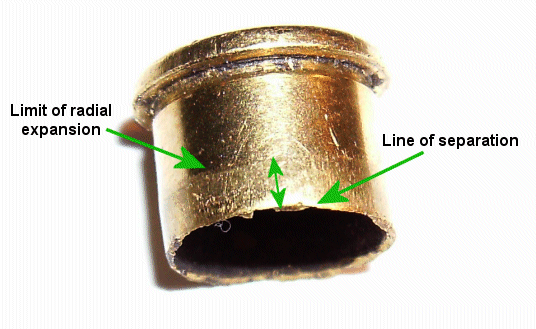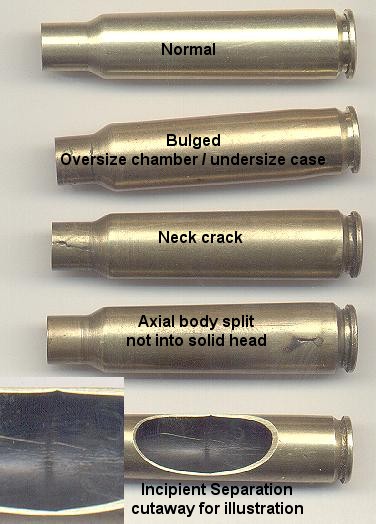-
Advisory Panel



Originally Posted by
ireload2

The case pressure ring material has to stretch radially until it it constrained by the chamber. There is some bending since the stretch occurs at an angle due to the proximity of the solid head. However this still results in the pressure ring being stretched buy the difference in diameter of the case and the chamber as well as the forces that stretch the case along it's longitudinal axis. Stretch along the relatively long longitudinal axis has the opportunity to get spread over a long portion of the case length. The radial stretch that occurs to the pressure ring area is concentrated over a short distance increasing it's damage to the case wall. If there was no stretching caused by the difference in diameters it would be possible to use a much smaller cases head with no consequences. We know that is not possible.
If this were true, we'd expect cases to separate at the junction of solid web and hollow body. However, they don't. They chop at some distance from obvious point where the body has expanded to meet the chamber. Nice theory, but the physical evidence seen in a typical separated case just doesn't seem to support it.

-
-
06-07-2009 06:38 PM
# ADS
Friends and Sponsors

-
Legacy Member

Hi Patrick,
The modulus used for steel is 30E6.
I used .390 as the inside diameter of the case assuming .030 wall thickness and a .450 case head diameter.
Bolt OD = .580
Bolt ID = .385 Actual measurement.
The loaded lengths were measured directly from a rifle
The receiver rails were measured as a set of small rectangles and triangles to calculate the receiver area in tension.
I don't doubt the O ring helps.
If the elastic limit of the brass is reached by the expanding and stretching due to head space and action elasticity then the case will be permanently deformed (stretched). This deformation is marked when comparing a front locking bolt gun to a Lee-Enfield. Assuming equal pressures it makes for markedly different case life.
-
-
-
Legacy Member


Originally Posted by
Parashooter

If this were true, we'd expect cases to separate at the junction of solid web and hollow body. However, they don't. They chop at some distance from obvious point where the body has expanded to meet the chamber. Nice theory, but the physical evidence seen in a typical separated case just doesn't seem to support it.
Parashooter,
You fail to see that the failure is not all due to longitudinal stretching or radial stretching. It is the combined stretching that you see.
You don't go from a case head diameter of .450 to a chamber diameter of .460 for free. The brass has to stretch. The location of stretch is not right at the solid head because the brass wall is usually tapered. Because of the taper the stretch gets concentrated where the case wall radial stretch is greatest the case is weakest. That is usually (but not always) where the case contacts the chamber wall.
-
-
Legacy Member


Originally Posted by
ireload2

Parashooter,
You fail to see that the failure is not all due to longitudinal stretching or radial stretching. It is the combined stretching that you see.
You don't go from a case head diameter of .450 to a chamber diameter of .460 for free. The brass has to stretch. The location of stretch is not right at the solid head because the brass wall is usually tapered. Because of the taper the stretch gets concentrated where the case wall radial stretch is greatest the case is weakest. That is usually (but not always) where the case contacts the chamber wall.
In my case the separation occurs right at the solid head not out like Paras photo. I have read the British and Australian
and Australian manuals of the day and had the care of the L E drumed into me by the men who who carried repaired and used them. They did not have lubes ,case tumblers etc which are from a more modern time. Todays technology is not as good it appears to some bygone technolgy. Todays brass composition is either different or the manufactureing process is different to historical composition or manufacture.
manuals of the day and had the care of the L E drumed into me by the men who who carried repaired and used them. They did not have lubes ,case tumblers etc which are from a more modern time. Todays technology is not as good it appears to some bygone technolgy. Todays brass composition is either different or the manufactureing process is different to historical composition or manufacture.
-
-
Banned

-
Banned

And just to make sure everyone is treated fairly here, NEVER ever trust anyone who thinks he knows more than Parashooter. It is sometimes and only rarely permissible to disagree with Parashooter on minor issues and procedures but one should NEVER criticize Parashooter on everything.
(The odds aren’t in your favor)
Personally I like the way I greased this one into the thread. 
(After all caster oil is considered medicinal) 
Last edited by Edward Horton; 06-07-2009 at 10:07 PM.
-
Advisory Panel


Patrick, a spacer (O-ring or other material) is useful on initial firing of new brass because it eliminates/reduces the component of case stretch due to cartridge end-play. The benefit is minimal if end-play is small, but can be significant when thin rims and/or generous headspace give the new case substantial end-play (more than .010" or so). As you note, it cannot eliminate the portion of case stretch due to action flex - but that is generally a minor element compared to end-play. I'm afraid reduced pressure and/or the presence of lubricant are the only readily-available solutions to stretching caused by action flex. Heavy-walled cases can last longer simply because they can stretch more before breaking.
My friend Mr. Horton - no irony, I enjoy our jousts - has shown us a number of authoritative warnings about lubricated cases and/or chambers. I appreciate the value of emphasizing and distributing them. Keeps some reckless folks out of trouble. On the other hand, I long ago learned to distrust (or resent) authority. For instance, I don't obey the many warnings I see about wearing seat belts. Nevertheless, I've never been injured in a car wreck - probably because I'm a very defensive and reasonably competent driver with a good measure of dumb luck. Seems to me some of the cautions we encounter might not be so absolutely imperative as they are purported to be. (Or maybe I'll fly through the windshield tomorrow.)
Believe nothing, no matter where you read it, or who said it - even if I have said it - unless it agrees with your own reason and your own common sense.
-- The Buddha
Ireload2, I now understand what you're getting at concerning radial expansion combining with axial to produce case thinning. It's certainly true, but if you'll do the math you'll find that thinning from radial expansion, spread over the entire circumference of the case, is minor (only about 2% when we expand from .450" to .460" diameter, for example - and only on initial firing unless we FL size), while axial stretching, confined to a narrow band (about .1" wide at most) somewhere ahead of the transition between wall and web, is much more significant and accounts for virtually all the cumulative thinning resulting in eventual separation.
Occasionally, of course, radial expansion is not evenly distributed around the circumference of the case. When that occurs, we see axial body splits ahead of the web, like the 4th example below -

-
-
Legacy Member

>>>radial expansion, spread over the entire circumference of the case, is minor (only about 2% when we expand from .450" to .460" diameter, for example - and only on initial firing unless we FL size), while axial stretching, confined to a narrow band (about .1" wide at most) somewhere ahead of the transition between wall and web, is much more significant and accounts for virtually all the cumulative thinning resulting in eventual separation.<<<
Please show us the number that you base the 2% upon.
I guess I disagree with your conclusion. When the entire .010 difference in diameter is accommodated by localized stretching of a case the amount of stretching .010 is significant to the thickness of the brass - normally near .030 thick.
Let me use a couple of extreme example.
1. What is the usual result of firing a 7.62 Nato round in a .30-06.
You get a blown out .308 case with no neck. There is usually no separation reported even thos the .308 case had little real headspace control.
2. What happens when a .270 is fired in a 7mm magnum?
Usually the rifle is wrecked because the case could not handle the radial stretching.
These are extreme example of case missfits but they serve to show the critical nature of having the case head fit the chamber closely.
There is another example of case to chamber misfit that exists with the 6.5 Arisaka . The Type 38 rifle is know to be very strong. It would exhibit very little spring with high pressure loads. After the first fire forming load it would have a fit from head to should to control the headspace. Yet ammo fired in these rifles give head separations due to the thinning of the brass where a huge step is formed due to the mismatch of the case head and the chamber.
. The Type 38 rifle is know to be very strong. It would exhibit very little spring with high pressure loads. After the first fire forming load it would have a fit from head to should to control the headspace. Yet ammo fired in these rifles give head separations due to the thinning of the brass where a huge step is formed due to the mismatch of the case head and the chamber.
One of my reasons for focusing on radial thinning is that on a an experimantal basis it is possible to use brass to eliminate most of it. By using larger brass you are left with only axial stretching forces.
-
-
Legacy Member

Just FYI
Quote from VarmintAls
About half way down the page
CONTROVERSY OR GOOD ENGINEERING.... Now some controversy. I polish my chambers with Flitz. I don't want excessive friction between the brass and the chamber wall. Some are going to argue with this, but I have thought long about this. I have tried it and it works and is good engineering. I polished the chamber in my new Virgin Valley (no longer in business) barrel and it has made quite an improvement. With a polished chamber, the friction coefficient is much less between the brass and the polished stainless steel chamber. The pressure is able to force the case head against the bolt face before the case walls grab the chamber. First, this lets the primer (on the first shot with new brass) protrude, but be immediately reseated in the primer pocket as the case head is pushed back. The brass does not stretch nearly as much as it would in a rough chamber. Now some will say that a polished chamber will increase the force of the bolt face (frame face on the Encore) and that is bad. WRONG! That is faulty logic. The force is increased on the bolt face, but that is where it belongs. As all modern rifles, the barrel and frame of the Encore are designed for strength. They are strong enough to support large diameter Magnum-belted calibers. The force from the much smaller area of the .223 case head is easily supported by the frame face. The brass case is designed to act as a bladder and encase the gas pressure. Trying to use the weaker brass to lighten the load on the action and bolt face of a rifle by having the brass grip the chamber is analogous to using a car's radiator to protect the bumper in a front-end collision. A polished chamber minimizes case stretching, reduces case head separation, and increases case life. More information on chamber finish here. To polish a chamber, I put Flitz on a cotton bore mop and a piece of cleaning rod long enough to be held in a drill motor. I polish for about 30 seconds or more at a 300 to 600 rpm speed. Sometimes I have to wrap a paper towel around the swab and put Flitz on it to get a good fit. Be sure that the end of the bore mop's metal part is much smaller than the bore and covered so it will not damage the rifling in front of the chamber.
-
-
Legacy Member

It has been said that oiling a case so that it does not adhere to the chamber is bad. That it damages the Lee-Enfield rifle. That it is counter to all the manuals. It is implied that the Lee-Enfield and all other rifles depend on the friction from the case to prevent damage to or over loading of the action.
So I will ask the following question.
If the case head is flush against the bolt when fired the bolt takes all the load right...That is all the load until the LE starts to stretch. Then the walls of the case begin to act as a brake connecting the case head to the chamber walls.
As the LE action stretches the case walls are stretched also until one of two things happen.
1. The pressure subsides
2. The case head separates
In case one the pressure subsided before the case was stretched enough to rupture. However the case was stretched since the LE action is not rigid.
In case two the case is stretched past its yield point and ruptures.
When it ruptures the brake formed by the case walls adhering to the chambers instantly disappears and the full load of the chamber pressure hits the bolt face.
Which is the worst case (no pun intended)?
A. An oiled case that is able to slip past the chamber and take up less of the load on the action while protecting the case walls against rupture.
B. A case that adheres to the chamber until it almost separates or separates putting the full load of the chamber pressure against the bolt face?
-

















 PM
PM

















